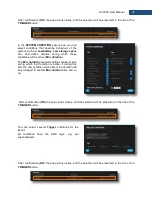
66
SV 200A User Manual
8.4.1 Configuration views
The
Configuration
view consists of several tabs that enable configuring measurement parameters
(
MEASUREMENT SETUP
), data saving (
STORAGE
), export of measurement data into CSV files
(
CSV EXPORT
), audio recording (
AUDIO RECORDING
), events triggering (
EVENT TRIGGERS
),
calibration of the instrument (
CALIBRATION
), auxiliary settings (
AUXILIARY SETTINGS
) and
performing the firmware upgrade (
FIRMWARE UPGRADE
).
To load the new configuration to the station, click the
button.
MEASUREMENT SETUP tab
In the
MEASUREMENT SETUP
tab, you can:
1. Select the
Measurement function
:
Level Meter
,
Octave 1/1
,
Octave 1/3
2. Update the
Instrument clock
3. Select the type of
RMS/Leq Integration
:
Linear
or
Exponential
4. Select
Filter
(
Z
,
A
,
C
) and
Detector
type (
Impulse
,
Fast
,
Slow
) for profiles
5. Select
Filter
for the spectrum (position appears when the
Octave 1/1
or
Octave 1/3
function is
selected).
RMS/Leq Integration
defines the detector type for the calculations of the
Leq
,
LEPd
,
Lnn
and
SEL
measurement
functions.
Linear
integration is required when you wish to obtain the true RMS value of
the measured signal. When this option is selected the values of the
Leq
,
LEPd
,
Lnn
and
SEL
functions
do not depend on the detector time constant (
Fast
,
Slow
or
Impulse
), defined for the profiles.
Exponential
integration
is required in some standards for
Leq
measurements. When this option is
selected the values of the
Leq
,
LEPd
,
Lnn
and
SEL
measurement
results depend on the detector time
constant (
Fast
,
Slow
or
Impulse
), defined for the profiles.
Such measurement results like
Lmax
,
Lmin
,
Ltm3
or
Ltm5
are always calculated with the
Exponential
integration and selected time constants. And vice versa, such results as
Lpeak
don’t use integration
at all.
1
5
4
3
2






























